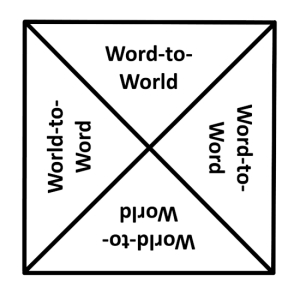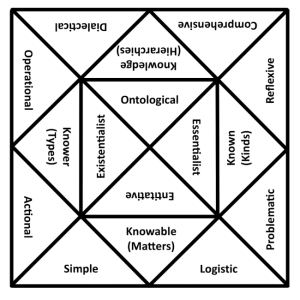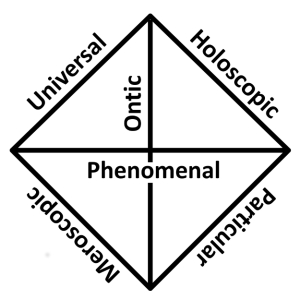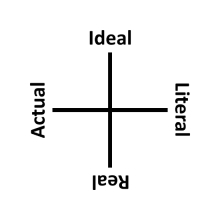 The notion of “Direction of Fit” can describe several associated concepts, from a specific one in “Speech Act Theory” (SAT) to the more general one in the “Philosophy of Mind” (POM). For SAT, the concept depends on whether words accurately describe the world (word-to-world), or if the world is actually altered by words (world-to-word) (or possibly both or neither). For POM, the concept is generalized to be between mind (or thought) and world, and of course, word could serve to mediate between mind (or thought) and world.
The notion of “Direction of Fit” can describe several associated concepts, from a specific one in “Speech Act Theory” (SAT) to the more general one in the “Philosophy of Mind” (POM). For SAT, the concept depends on whether words accurately describe the world (word-to-world), or if the world is actually altered by words (world-to-word) (or possibly both or neither). For POM, the concept is generalized to be between mind (or thought) and world, and of course, word could serve to mediate between mind (or thought) and world.
I propose that direction of fit could also be enlarged to encompass the fits of world-to-world and word-to-word.
Perhaps the notion of world fitting to world is tautological, that it is always true by necessity. For any fit of world to world is natural, in as much as we understand it, because anything else would be super-natural. This is the realm of science then, when we try to explain how the mechanism of the world behaves in its ordered operation. I imagine that we could also put engineering and technology in this case, since we are trying to create an artifact in the world that meshes with the normal goings on of nature. If it meshes very poorly, it either breaks or nature does instead.
The notion of word fitting to word is interesting as well. It is not given that words I write will fit with the words that you read, or there is a proper fit between speaking and listening. I guess the art of rhetoric can be placed here, as how we can fashion our words best to convince or explain or engage. In the POM sense, perhaps any art could be included as well, from literature to music to visual arts, since they strive to convey thoughts to thoughts. I am reminded of the notion of the perfect language in accurately describing the world or of complete understanding between minds.
Maybe words describing world could also be science, but perhaps its proper realm should be more of history or the states of human affairs. This is more in agreement with the opposite direction of World-to-Word, or world fitting to word.
Maybe I’m just thinking of a certain fourfold of Richard McKeon, and want to make a correspondence of
- Word-to-World => Thought
- World-to-Word => Action
- Word-to-Word => Word
- World-to-World => Thing
although I’m not sure this works.
Further Reading:
https://en.wikipedia.org/wiki/Direction_of_fit
https://plato.stanford.edu/entries/speech-acts/
https://en.wikipedia.org/wiki/Triangle_of_reference
https://en.wikipedia.org/wiki/The_Message_in_the_Bottle#%22The_Delta_Factor%22
https://www.jstor.org/stable/44290001
https://plato.stanford.edu/entries/belief/
https://plato.stanford.edu/entries/intention/
http://www.gavinjensen.com/blog/category/Philosophy+of+Language
[*12.96, *12.98]
<>
















